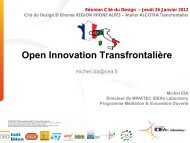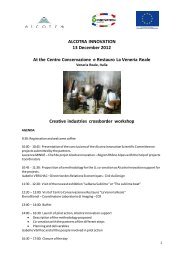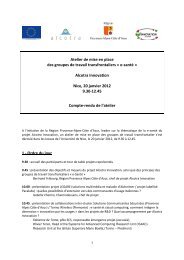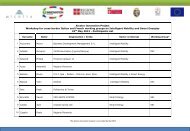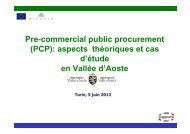Best practices Database for Living Labs - ALCOTRA - Innovation
Best practices Database for Living Labs - ALCOTRA - Innovation
Best practices Database for Living Labs - ALCOTRA - Innovation
Create successful ePaper yourself
Turn your PDF publications into a flip-book with our unique Google optimized e-Paper software.
3.4 The Technological Plat<strong>for</strong>m Model<br />
The “process oriented” definitions above leave the additional issue open of introducing and describing a<br />
“<strong>Living</strong> Lab plat<strong>for</strong>m”, whereby knowledge is shared and the collective work, including social intelligence, of<br />
multidisciplinary teams and user communities is crystallized into new and emerging concepts, artefacts and<br />
ultimately services.<br />
Marc Pallot [26] gives emphasis to <strong>Living</strong> <strong>Labs</strong> as technological plat<strong>for</strong>ms (see next Figure) offering research<br />
and innovation services <strong>for</strong> the design, exploration, experimentation and evaluation of new and innovative<br />
ideas, usage scenarios, and application prototypes. Within a <strong>Living</strong> Lab, an iterative process takes place -<br />
whatever innovation is to be generated - that links together the following four activities:<br />
1. Co-creation of new ideas, concepts, artefacts and application scenarios, by means of open sessions<br />
of collective creativity involving all concerned stakeholders and especially end users;<br />
2. Exploration of alternative usage scenarios through setting the scene by the implementation of<br />
different immersive techniques within real-life environments;<br />
3. Experimentation done on various assessment scenarios <strong>for</strong> concrete applications and/or service<br />
prototypes by the use of the <strong>Living</strong> Lab’s technological plat<strong>for</strong>m, also within real-life environments;<br />
4. Evaluation of the resulting exploitation scenarios on the basis of metrics <strong>for</strong> measuring the Quality<br />
of Service as well as the Quality of Experience, which both allow anticipating the potential degree<br />
of future adoption by the user communities involved.<br />
Figure 9: <strong>Living</strong> <strong>Labs</strong> as Technology Plat<strong>for</strong>ms (from: [26])<br />
The FP7 ICT STREP ELLIOT (Experiential <strong>Living</strong> <strong>Labs</strong> <strong>for</strong> the Internet Of Things, http://www.elliot-project.eu)<br />
adopted this model to develop IoT technologies and Ambient Intelligence (AmI) services by and <strong>for</strong> the<br />
users, supported by a KSB (Knowledge-Social-Business) Experience Model [27] and by an innovative ICT<br />
Plat<strong>for</strong>m operating as a knowledge and experience gathering environment. This combination of user driven<br />
experimentation and experiential design approaches is expected to positively impact on the development<br />
and adoption of IoT technologies and services.<br />
The project is co-funded by the ERDF<br />
Page 19 of 78



